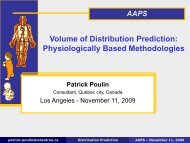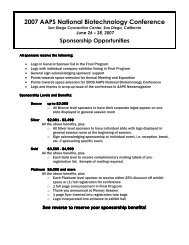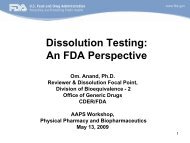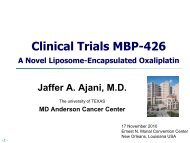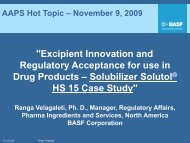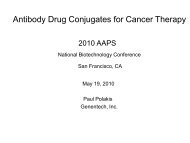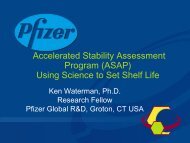Preliminary Program - American Association of Pharmaceutical ...
Preliminary Program - American Association of Pharmaceutical ...
Preliminary Program - American Association of Pharmaceutical ...
You also want an ePaper? Increase the reach of your titles
YUMPU automatically turns print PDFs into web optimized ePapers that Google loves.
45<br />
2009 AAPS Annual Meeting and Exposition<br />
Clinical Pharmacology and Translational Research (CPTR) <strong>Program</strong>ming<br />
Thursday, November 12, 2009<br />
THURSDAY SYMPOSIA<br />
8:30 am – 11:00 am<br />
Using Modeling and Simulation to<br />
Safely Adjust Dose Regimens for Obese<br />
Patients<br />
Symposium<br />
Obesity has reached epidemic proportions<br />
worldwide. Obesity presents major health, social,<br />
and economic implications. Obese patients are<br />
more susceptible to a variety <strong>of</strong> chronic diseases<br />
than individuals with normal body composition.<br />
For example, obese patients frequently have<br />
hypertension, arterial sclerosis, and other<br />
cardiovascular diseases. Diabetes is also common in<br />
obese patients. Despite increased pharmacotherapy<br />
among obese patients, there is little information<br />
about dose adjustments for this population.<br />
Particularly for drugs with a narrow therapeutic<br />
index. The main factors affecting tissue distribution<br />
are body composition, regional blood flow, and the<br />
affinity <strong>of</strong> the drug for plasma proteins and/or tissue<br />
components. All these factors are altered in obese<br />
patients. The obese have larger absolute lean body<br />
masses as well as fat masses than lean patients.<br />
However, the percentage <strong>of</strong> fat per kilogram <strong>of</strong> total<br />
body weight is markedly increased. Drug clearance<br />
can also be altered in obese patients. Morbid<br />
obesity is strongly associated with non-alcoholic<br />
fatty liver disease, and cytochrome P450 is<strong>of</strong>orm<br />
expression is altered, but no clear overview <strong>of</strong> drug<br />
hepatic metabolism in obesity is currently available.<br />
Pharmacology studies have reported different<br />
results on renal function in obese patients as well,<br />
making it difficult to forecast the pharmacokinetic<br />
behavior <strong>of</strong> drugs in obese patients. There have<br />
been several published reviews <strong>of</strong> various strategies<br />
for dose adjustments in obese patients. These<br />
reports suggest that a number <strong>of</strong> widely used<br />
empiric strategies for dose adjustments in obese<br />
patients, including a priori dose reduction or<br />
dose capping, are inappropriate and should be<br />
discouraged. However there have been no suitable<br />
size descriptors developed for dose adjustments<br />
across a wide range <strong>of</strong> body compositions. The lack<br />
<strong>of</strong> information on mechanisms for dose adjustment<br />
in the obese may be partly attributed to insufficient<br />
knowledge about pharmacokinetic parameters as<br />
a function <strong>of</strong> body composition due to the exclusion<br />
<strong>of</strong> obese subjects from clinical trials. Contributing<br />
to the problem is the myriad <strong>of</strong> concomitant health<br />
issues associated with obesity. Modeling and<br />
simulation during drug development may provide<br />
insights about safe dose adjustments in drugs in<br />
the obese patient population.<br />
Moderator<br />
Diane R. Mould, Ph.D.<br />
Projections Research Inc<br />
Thoughts on a Mechanistic Approach to Build<br />
Predictive PK Models for the Overweight<br />
and Obese<br />
Bruce Green, Ph.D.<br />
Projections Research, Inc.<br />
Estimating Lean Body Weight in Children<br />
Stephen Duffull, Ph.D.<br />
University <strong>of</strong> Otago<br />
Anesthetics Drugs and Morbid Obesity<br />
Hendrikus J. Lemmens, M.D., Ph.D.<br />
Stanford University<br />
Considerations for Dose Adjustment in Obesity<br />
Rajnikanth Madabushi, Ph.D., invited<br />
U.S. Food and Drug Administration<br />
THURSDAY ROUNDTABLES<br />
9:00 am – 11:00 am<br />
Evaluating Fit-for-Purpose Models:<br />
Consensus or Controversy<br />
Roundtable<br />
Disease/PK/PD/Trial Models are now being<br />
increasingly used to aid decisions in industry,<br />
hospital, and regulatory settings. It is generally<br />
agreed that the adequacy <strong>of</strong> a model should be<br />
judged mainly based on its intended application.<br />
While modeling zealots continue to debate on<br />
what term best fits the process <strong>of</strong> evaluating model<br />
adequacy (model validation, model evaluation, etc.)<br />
the more critical issue is the lack <strong>of</strong> consensus on<br />
what constitutes an adequate model for a specific<br />
application. The objective <strong>of</strong> this roundtable is to<br />
debate on the appropriateness <strong>of</strong> models frequently<br />
used in 3 areas <strong>of</strong> drug development; models<br />
derived from in vitro, preclinical and literature<br />
(study-level) data on competitors to inform decisions<br />
in preclinical and clinical development, models<br />
used to select doses for Phase 3 testing, and models<br />
used for regulatory decisions, specifically to derive<br />
labeling statements. The overarching question<br />
is, what are the minimally acceptable statistical,<br />
biological, and predictive (S, B, P) properties <strong>of</strong><br />
such models? To encourage an interactive session<br />
on specific items, panel presentations will focus on<br />
the following scenarios <strong>of</strong> model application. First,<br />
intended application using exposure-response<br />
models for efficacy and safety to design a dose<br />
response study to find optimal dose(s) for Phase<br />
3 testing. What are minimally acceptable S/B/P<br />
properties for such models? What visual and<br />
statistical tools would you use to judge model<br />
adequacy? Second, intended application<br />
benchmark the magnitude <strong>of</strong> efficacy <strong>of</strong> your<br />
compound relative to competitors based on<br />
literature data to make a go/no-go decision.<br />
What are minimally acceptable S/B/P properties<br />
for such a model that combines subject level data<br />
for your compound with study level data with<br />
competitors? What visual and statistical tools<br />
would you use to judge model adequacy? Finally,<br />
intended application labeling statement to include<br />
the estimated magnitude <strong>of</strong> mean change in PK/<br />
efficacy/safety under conditions <strong>of</strong> an interacting<br />
agent or in a special population. What are minimally<br />
acceptable S/B/P properties for such models? What<br />
visual and statistical tools would you use to judge<br />
model adequacy?<br />
Moderator<br />
Sriram Krishnaswami, Ph.D.<br />
Pfizer Global Research & Development<br />
A Pharmacologist’s View<br />
Nick Holford, M.D., M.S.<br />
University <strong>of</strong> Auckland<br />
A Statistician’s View<br />
Kenneth Kowalski, M.S.<br />
A2PG<br />
A Regulator’s View<br />
Yaning Wang, Ph.D., invited<br />
U.S. Food and Drug Administration






